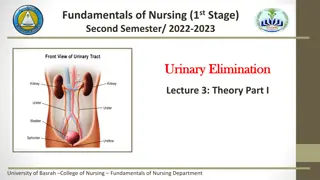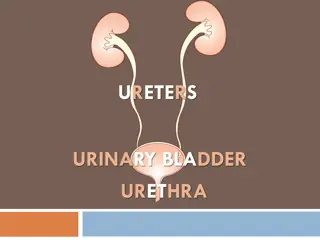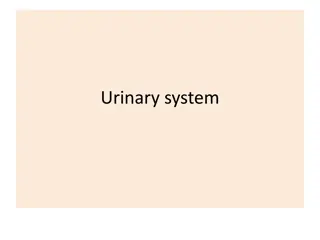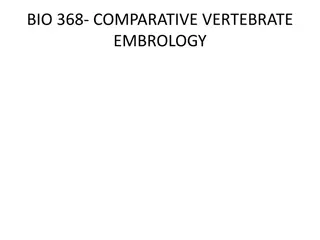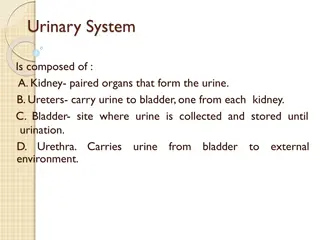Development of the Urinary Bladder and Urethra in Embryology
Understanding the embryonic development of the urinary bladder and urethra involves studying the formation of the cloaca, division of the urogenital sinus, absorption of mesonephric ducts, position and fate of the urachus, and anomalies related to these structures. The cloaca, primitive urogenital sinus, and their divisions play crucial roles in the development of adult urinary and reproductive organs. This comprehensive overview delves into the intricate process of organogenesis in the urogenital system.
Download Presentation

Please find below an Image/Link to download the presentation.
The content on the website is provided AS IS for your information and personal use only. It may not be sold, licensed, or shared on other websites without obtaining consent from the author.If you encounter any issues during the download, it is possible that the publisher has removed the file from their server.
You are allowed to download the files provided on this website for personal or commercial use, subject to the condition that they are used lawfully. All files are the property of their respective owners.
The content on the website is provided AS IS for your information and personal use only. It may not be sold, licensed, or shared on other websites without obtaining consent from the author.
E N D
Presentation Transcript
Development of The Urinary Bladder And Urethra : 2]. [ Embryology 436 Important Dr. notes Explanation M E D I C I N E KING SAUD UNIVERSITY - We recommend you to study anatomy of the Bladder and urethra .
O B J E C T I V E 1. Describe the cloaca and the formation of the urogenital sinus. 2. Discuss the division of the urogenital sinus into various pats and name the adult organs that are derived from each part. 3. Describe how the caudal parts of the mesonephric ducts are absorbed into the urogenital sinus and the significance of this embryonic events. 4. Discuss the position of the urachus and its significance and fate. 5. Describe the various anomalies concerned with the urinary bladder and urethra.
Introduction . * Just More explanation for the whole idea: First the embryo was 2 layers (endoderm , ectoderm), later it become 3 layers (endoderm , mesoderm , ectoderm). These layers folded together in growth space, than it give:( head fold , tall fold, two lateral fold.) The Tall fold gives the hind gut The last part of hind gut dilated and it s callCloaca Than the Cloaca divided by sptum into ventral part and dorsal part.
Cloaca - It is the dilated terminal part of the hind gut. It receives 1- the allantois and 2- the mesonephric ducts. Its floor is closed by the cloacal membrane. - A mesodermal urorectal septum divides the cloaca and cloacal membrane into: (2parts) 1- Ventral part: (from its name it will give part to urinary system and part to GIT)(this part that we need to know it in this lecture ): the primitive urogenital sinus that communicates with the allantois anterior and the mesonephric ducts two lateral . Its floor is the urogenital membrane. Cloacal Membrane 2- Dorsal:)at the end of GIT and will give rectum . forms the rectum and upper part of anal canal. Its floor is the anal membrane. ): the anorectal canal that *the two parts(ventral and dorsal) will be separated completely from each other by the mesodermal urorectal septum. ) )
Primitive Urogenital Sinus - this slide is very important - Primitive urogenital sinus: (Its divided into three parts): 1- A cranial (vesical*) part: forms most of the bladder (except the posterior surface or the trigone in both genders) and continuous with the allantois. 2- A middle (pelvic) part: forms main part of male urethra (there is a small part in the end of the penis is ectodermal in origin like the skin) and entire female urethra(forms all female urethra). 3- A caudal (phallic**) part: grows towards genital tubercle(shares in formation of male urethra). *relating to the urinary bladder **relating to penis
Urinary Bladder - Bladder develops mainly from the vesical part (see the previous slide) of the urogenital sinus. - The trigone is derived from the absorbed caudal ends (distal parts)of the mesonephric ducts. the end part of both 2 mesonephric ducts will be absorbed by urogenital sinus .) ( The epithelium of bladder is endodermal in origin. (the most inner layer originate from endoderm) The other layers of bladder are derived from the splanchinic mesoderm. median . The allantois is at first : 1- continues with the bladder, 2- then it becomes a thick fibrous cord urachus ( ) which extends from the apex (from proximal part of urachus) of the bladder to the umbilicus. (Allantois connect apex with umbilicus umbilical ligament. : ) Trigone extra picture At birth,it is represented by the median umbilical ligament (from distal part of urachus). median umbilical ligament ) - ( After absorption of the mesonephric ducts to form the trigone, the ureters open separately in the bladder. In infants and children, the bladder is an abdominal organ, then it starts to enter the greater pelvis or false pelvis ( between the 2 iliac bones)at about 6 years and becomes a pelvic (true pelvis) organ until after puberty at age 14 to 15. So the urinary bladder mainly developed from 1- the vesical part of urogenital sinus and 2-absorbed part of mesonephric duct
Urethra Indifferent stages: (the urethra in this stage is the same for both genders) ) ). ) The genital tubercle (mesenchymal elevation) develops at the cranial end of the cloacal membrane. ) Two urethral folds, develop on either side of the urogenital membrane. (After separation) ) ) Laterally two labioscortal folds develop on either sides of the urethral folds. 2 urethral folds in male fuse with each other to close the penile urethra. 2 urethral folds in female remain separateto form labia minora. (Labioscrotal folds) Urogenital membrane Extra: .
Female Urethra -The entire female urethra is derived from endoderm of the pelvic (middle) part of the urogenital sinus. - The external urethral orifice opens dorsal to the glans clitoris. The genital tubercle will form female clitoris which is ventricle in position to the external urethral orifice. : Male Urethra - The genital tubercle elongates forming the phallus, which the precursor of the penis. Remember it forms the female clitoris. - Most of the male urethra (prostatic, membranous and spongy part) are derived from endoderm of the pelvic (middle) part of the urogenital sinus. - The distal part of male penile urethra in glans penis starts as ectodermal solid cord that grows towards the root of penis to meet the spongy urethra, later it canalizes. - So the terminal part of male ureathrais ectoderm, while the rest of it are endoderm from pelvic and phallic part of urogenital sinus.
Anomalies - This slide is very important - There are 3 anomalies : (1- extrophy of bladder 2- urachal anomalies 3- Urethral anomalies ). And they are in male only. http://medlibes.com/uploads/Screen%20shot%202010-07-14%20at%201.38.29%20PM.png 1. Extrophyof the bladder (ectopia vesicae): It is an abnormal exposure of the posterior wall of the bladder (trigone or base of bladder) due to a defect in the anterior abdominal wall and anterior wall of the bladder. very rare ) ) 2. Urachal (remember! it is the cord extends from the urinary bladder to the umbilical and eventually form the medial umbilical ligament) anomalies: A. Urachal fistula(no fibrosis): the entire urachus remains patent and allows urine to escape from the umbilicus. Open way between the urinary bladder and the umbilical which is supposed to be closed ( after fibrosis ). B. Urachal sinus(fibrosis just in terminal part): discharge serous fluid from the umbilicus. C. Urachal cyst (fibrosis just in the cranial and caudal part): persistence or remnant of epithelial lining of urachus. (Contain serous fluid in side cyst ). Video for extra explanation
Cont.. Anomalies - This slide is very important External urethral orifice 3- Urethral anomalies: Penile urethra In normal male the penile urethra must open in the external urethral orifice. A. Hypospadius: it s the most common anomaly, with incomplete fusion of the urethral folds the complete fusion described in slide 7! , and abnormal opening of the urethra occur along the ventral (inferior) aspect of the penis. B. Epispadius: is a rare anomaly , in which the urethral meatus is found in the dorsal superior surface of penis, it is most often associated with extrophy of the bladder. - See You Our Doctors Next Year ..
SUMMARY Urinary Bladder In infants and children the bladder is an abdominal organ. It starts to enter the greater pelvis at about 6 years and become a pelvic organ until after puberty Primitive urogenital sinus divided into three part: 1- cranial (vesical part) 2- middle (pelvic part) 3- caudal (phallic part) forms most of the bladder and continuous with the allantois forms main part of male urethra and entire female urethra grows towards genital tubercle. Anomalies 1- Exstrophy of the bladder (Ectopiae vesica) 2- Urachal anomalies: 3- Urethral Anomalies: (exposure of the posterior wall of the bladder due to a defect in the anterior abdominal wall and anterior wall of the bladder) 1- Urachal cyst 2- Urachal sinus 3- Urachal fistula 1- Hypospadius *common* 2- Epispadius *rare* (remnant of epithelium) (discharging serous fluid from the umbilicus) ( entire urachus remains patent with urine escape from umbilicus). (discharging (incomplete fusion of urethra) (associated with exstrophy of the bladder )
MCQs 1- The cloaca is the dilated terminal part of the hind gut, however witch of the following ducts does It receives. A- Allantois duct. B- mesonephric duct. C- Both of them D- None of them 2- The Primitive urogenital sinus is divided into three parts, witch of the following is the correct order for them from up down. A- vesical part, phallic part, pelvic part. B- vesical part, pelvic part , phallic part. C- pelvic part, vesical part, phallic part. D- phallic part, vesical part, pelvic part. 3- Witch of the following forms most of the bladder and continuous with the allantois. A- The vesical part of the primitive urogenital sinus. B- The pelvic part of the primitive urogenital sinus. C- The phallic part of the primitive urogenital sinus. D- None of them 4- Witch of the following forms the female urethra? A- The vesical part of the primitive urogenital sinus. B- The pelvic part of the primitive urogenital sinus. C- The phallic part of the primitive urogenital sinus. D- None of them . 5- A mother of 7 weeks old child came to the pediatric clinic complaining of discharge serous fluid from the baby belly button, witch of the following is most likely be the cause. A- Urachal cyst B- Urachal sinus C- Urachal fistula D- Epispadius 6- Hypospadius.Witch of the following best describe: 1-C 2-B 3-A 4-B 5-B 6-A A- incomplete fusion ofthe urethral folds, and abnormal openings of the urethra occur along the ventral (inferior) aspect of the penis. B- is a rare abnormality, in which the urethral meatus is found on the dorsum of penis, it is most often associated with exstrophy of the bladder. C- the entire urachus remains patent and allows urine to escape from the umbilicus.
ANY SUGGESTION OR ISSUE USEFUL VIDEOS https://youtu.be/v3Tv86bITZ4?t=249 @Embryology436 Embryology 436 Embryology436@gmail.com Editing file
TEAM MEMBERS TEAM LEADERS : B O Y S : Abdulrahman Alharbi Abdulrahman Alrasheed Rayan Alqarni Abdulkarim Alharbi SAAD ALRUSHOUD NEHAL BEYARI G I R L S : Razan Alotaibi Thikrayat Omar Do aa Walid Ohood Abdullah Nouf Aloqili - Special Thanks To Team 435 EDITING By: MUHANNED ALZAHRANI


